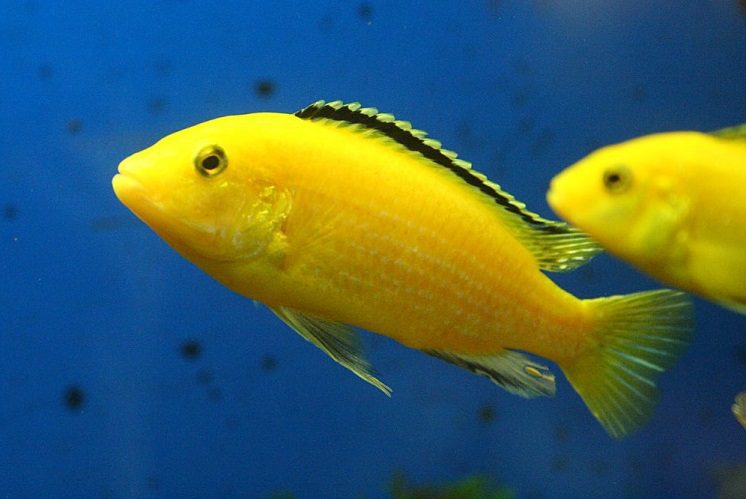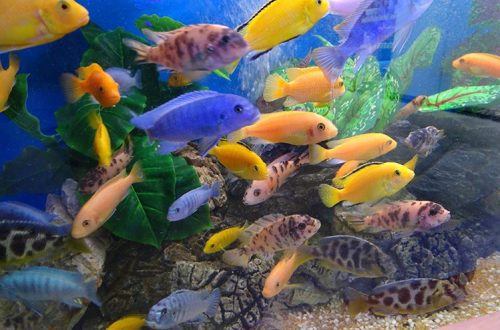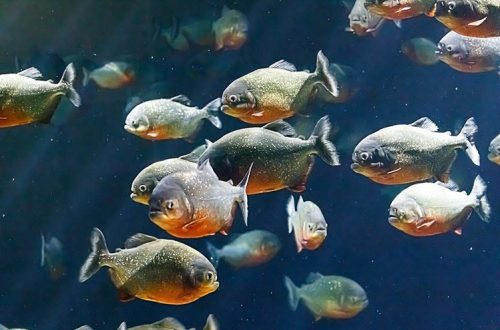
How to feed cichlids?
Contrary to popular belief, not all cichlids are omnivores. The diet of these mobile aquarium fish differs significantly depending on the genus. So, cichlids are usually divided into carnivores and herbivores. And only a few fish really have mixed preferences. So what to feed cichlids and what every aquarist needs to know?
Cichlids are bright and very mobile aquarium fish, famous for their excellent appetite. Carnivorous cichlids – the most active predators – tend to catch on their way everything that seems to them more or less edible. Their herbivorous counterparts will also never refuse a delicious lunch. Well, it would be superfluous to even talk about the appetite of omnivorous cichlids.
However bottomless the cichlid’s stomach may seem, overfeeding continues to pose a serious danger. Unfortunately, a huge number of aquarium fish die just because of overfeeding and an unbalanced diet in general, because novice aquarists take great pleasure in feeding their pets more often. And products from the human table are often used, which is detrimental not only for fish, but also for all pets. The consequences of malnutrition will definitely manifest themselves – a little earlier or a little later – and, perhaps, in the most categorical form (up to the death of the fish). Therefore, if you want your cichlids to live happily ever after, without knowing digestive problems, follow these rules:
– do not use food from the human table to feed the fish;
– choose high-quality balanced feed from trusted brands;
– when choosing a food, carefully read its description: for which species / subspecies of fish it is intended, whether it is complete, whether the expiration date has expired, etc .;
– the form of food should correspond to the nutritional characteristics of your cichlid species. There are diets in the form of sinking pellets, flakes, floating balls, etc. The choice of a particular form depends on which layer of water your aquarium inhabitants prefer to eat;
– it is better if the food for cichlids is rich in natural pigments – carotenoids. They make the color of the fish brighter and are powerful antioxidants;
– before buying food, be sure to check the integrity of the packaging;
– carnivorous cichlids can be periodically pampered with treats with bloodworms (for example, Tetra Fresh Delica);
– do not forget that cichlid cichlids are different, and if a herbivorous cichlid does not appreciate crustaceans, then a carnivorous one will ignore a dinner of algae. To avoid confusion in feeding, it is recommended to keep each type of cichlid separately.

The food you choose should fully meet the nutritional needs of your cichlid species.
For example, for herbivorous subspecies (Mbuna group, tropheus, petrochromis, some astrotelapia, etc.), Tetra Cichlid Algae granular food is ideal. This balanced food contains a full range of nutrients necessary for the harmonious development of fish. The green color of some of the granules indicates the content of seaweed, in particular, spirulina, which strengthens the immune system and prevents bacteriological diseases.
Carnivorous cichlids (virtually all types of African cichlids, astronotus, acara, cichlids, etc.) require food enriched with animal protein and characterized by an optimal balance of proteins and fats for proper growth of the fish (for example, Tetra Cichlid Color pellet food). It is better if approximately 50% of the food composition for carnivorous cichlids is protein.
In addition to diets for carnivorous and herbivorous fish, there are generalized food lines that are suitable for most types of cichlids. As a rule, such feeds are made in the form of chips or granules of different colors: green and, for example, orange. Green chips or kibbles contain algae, while orange ones contain animal protein, such as krill meat. Carefully balanced food for all types of cichlids (for example, Tetra Cichlid Pro) is rich in vitamins, minerals and amino acids, which are perfectly absorbed by fish, and do not require additional vitamin supplementation.
For cichlid species such as red parrots, flowerhorns, discus or dwarf cichlids, you can find separate foods designed specifically for these subspecies.
The daily dose for aquarium fish is the amount of food that they can handle within a few minutes. This dose can be given once a day, or can be divided into three feedings. For adult fish, this is not critical, but it is advisable to feed fry in small portions and more often. Food that has not been eaten in a few minutes must be removed from the aquarium.
Make it a rule not to overfeed your aquarium fish. Overfeeding is much more dangerous than mild undernourishment (within reason).
Here we have listed the basic rules of feeding. At first glance, it may seem that there are too many of them and the topic of feeding is incredibly complicated. But in practice, as you learn more and more about the needs of the fish, you will follow these steps by default without thinking too much about them.
May everyone in your underwater kingdom be full and healthy!





